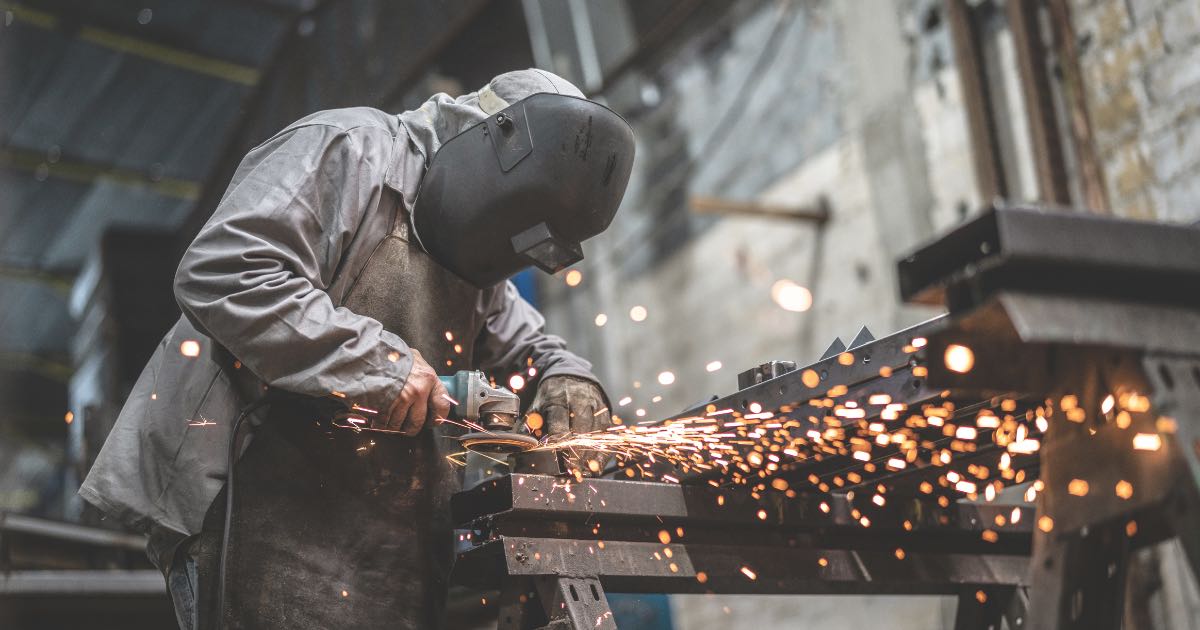Can You Weld Galvanized Steel?

Although welding galvanized steel is popular, there are still concerns about the welders' health and the material itself.

Yes, you can weld galvanized steel. The welding of galvanized steel is an important and useful welding technique. This welding technique is particularly utilized in producing galvanized steel gratings or wire cloth.
Although welding galvanized steel is popular, there are still concerns about the welders' health and the material itself. However, with adequate understanding and abilities, the welders' health will not be jeopardized. Additionally, gaining enough knowledge on this procedure will also ensure a good welded result. To help you understand things even more, here is a blog article on how to weld galvanized steel safely.
What Is Galvanized Steel?
Galvanized steel is simply iron covered in zinc, making it more resistant to rust. Iron is the base material for most steels, but it corrodes when exposed to water and oxygen over time.
Galvanized steel is a type of steel that is quite popular nowadays. One of the primary reasons for this is its long-lasting nature. Not only does it boast the same elasticity as steel, but it is also resistant to corrosion, like its zinc-iron coating.
Automobile manufacturers, wind and solar industries, construction businesses, and telecommunication companies are among the industries that utilize galvanized steel. Galvanized steel is also a popular material for contemporary steel frame structures.
Issues You Might Encounter When Welding Galvanized Steel
When welding galvanized steel, welders may come across the following
issues.
Corrosion Resistance Issues
A common obstacle during welding galvanized steel is the steel's corrosion resistance. Galvanizing prevents rust by generating a zinc barrier; however, you first need to remove the zinc from the welded area for there to be no corrosion. The only way to do this is to galvanize the steel again after you have completed welding it. Even though it requires more time, it is still a practical method that will preserve your material's resistance to corrosion.
Zinc Coating Issues
Another difficulty when it comes to welding galvanized steel is the zinc coating on the metal. This material makes it difficult to weld because the coating creates obstacles and defects in the weld.
In order to weld galvanized steel effectively, a skilled welder is necessary. Additionally, the zinc coating should be removed from the welding area to solve the coating issue. Alternatively, a filler material can also be used on the portion of the welding area that is coated with zinc.
Potential Health Issues When Welding Galvanized Steel
Other than material issues, there are also health risks that operators may encounter. To learn more about these hazards, read more below.
Short-Term Health Issues
Galvanized steel, when welded, gives off easily vaporized zinc oxide fumes that will mix with the air. Inhaling these fumes can lead to short-term health effects; welders may experience flu-like symptoms once they inhale these gasses and might present Metal Fume Fever. These include nausea, headaches or a high fever, shivers, and thirst, which usually go away 48 hours after exposure.
Long-Term Health Issues
A small amount of lead is present in galvanized coatings. This lead will turn to vapor when welding and create fumes containing lead oxide. Inhaling these gasses can cause long-term health problems such as brain damage, cancer, and complications with your nervous system. It is important to wear proper safety gear at all times to protect yourself from these dangers
Safety Gear and Training
The lack of welder safety training is the root cause of many welding-related accidents. Welders need to be properly trained in order to minimize risks. They should keep the welding shield and their face out of fumes and maintain a proper position, so that clean airflow is maximized. This will also prevent oxidized dust from accumulating inside the welder's shield.
How To Improve Welding Safety
Prioritize safety while welding by following these tips:
Wear Adequate Gear
Appropriate welding personal protective apparel should start with welders' equipment. Welding jackets, gloves, boots, and helmets, are all examples of this sort of protection. When welding galvanized steel, especially if there are a lot of smaller particles in the heat, you'll need a respirator. High-top leather shoes or boots are better foot protection options than low-top sneakers. Make sure your pants reach over your footwear. Avoid wearing cloth shoes since they will quickly flame up. Furthermore, UV and infrared radiation exposure can damage your skin while welding without proper protection.
Ensure The Air Is Clean
Welding is a hazardous process that can cause harm to the welder and those around him. Because of the smoke and gasses produced during welding, working in a well-ventilated area is important. If the welder operates in a confined place, use an exhaust hood to remove the fumes from the space while ensuring enough fresh air for breathing.
Wear Proper Eye Gear
If you are not wearing any protective eyewear and are exposed to welding arc rays for even a few seconds, you might experience an arc flash. This is an uncomfortable condition in the eyes that can last several hours. So, whenever you weld, wear approved safety goggles with side shields and earplugs or some other type of protective eyewear.
Protecting Your Galvanized Steel
The basics of product care and maintenance are important to follow if you want to avoid or reduce common problems with galvanized steel. Here are some steps on how to do so:
- If you want your galvanized products to last, don't store them in a damp or poorly ventilated area. Instead, find a dry location with good ventilation.
- To avoid corrosion, do not allow galvanized steel products to come into direct contact with dissimilar metals like brass and copper, especially in corrosive environments.
- Galvanized steel products should not be exposed to a pH of between 6 and 12 because the galvanic coating can corrode more rapidly than normal.
- Do not use abrasive cleaners on galvanized steel items. On the outside space of the galvanized steel, a thin layer of insoluble zinc corrosion material has formed. This is termed a patina. The galvanized steel is protected by this patina. If you were to clean too vigorously, this protective film would be washed away. As a result, more zinc will be used up. The durability of the galvanized steel product would subsequently be reduced due to this process.
Wrapping Up
If you have no experience welding galvanized steel, it can be dangerous. Always take the necessary safety precautions when working with these materials. If you want to avoid complications while welding galvanized steel, use the right approach. If you need help, don't hesitate to reach out to an expert; it could be the difference between life and death.
Back to the blog